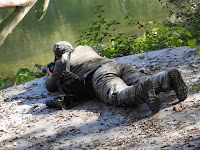Our birding guide, the man from the Himalayas !
Neer is the birding guide provided to us by Strabo Pixel Club during our three day visit to Sattal. In his early twenties, Neer has been a birding guide for the last six years. Over the years, Neer keenly observed the behavior of birds, listened to their calls, learnt their breeding habits and had insights into their habitat and could tell with precision where one could see a particular bird.
Neer lives in the forest area of Sattal in a secluded area all by himself as he says that being alone in the lap of nature gives him an advantage of remaining focussed and concentrated on his passion which he does not consider just merely a job.
 |
| Neer on the right |
Neer says that he wants to do something for the himalayas during his lifetime. He says with a glint in his eyes that he was born for the himalayas, he lives for the himalayas and will die for the himalayas. He indeed has grand plans which includes involving the local community in improving the natural biodiversity in the area. According to him, birding tourism in the area has a vast potential and needs to be exploited in a manner that it does not exploit the natural environment. He laments that some people come and throw garbage in the area spoiling the beauty of the forests and the mountains.Many a times he had to face their wrath for pointing it out to them but he boldly tells them to clean up or leave the place.
Coming back to birding, Neer says that he prefers serious birders and that too in small numbers. He says that the birds need to be observed from a distance as they too want their privacy to be maintained. According to him, birding is all about observing with patience.
Neer has been a birding guide to many including birders from Germany, Denmark and USA with whom he has been in constant touch. Besides birding, Neer is into adventure sports including trekking. He also has interest in metaphysics and philosophy.
Thank you Neer for being an excellent birding guide to us during our stay in Sattal and showing us exotic birds and thank you Strabo Pixel Club for getting Neer on board for us.


























